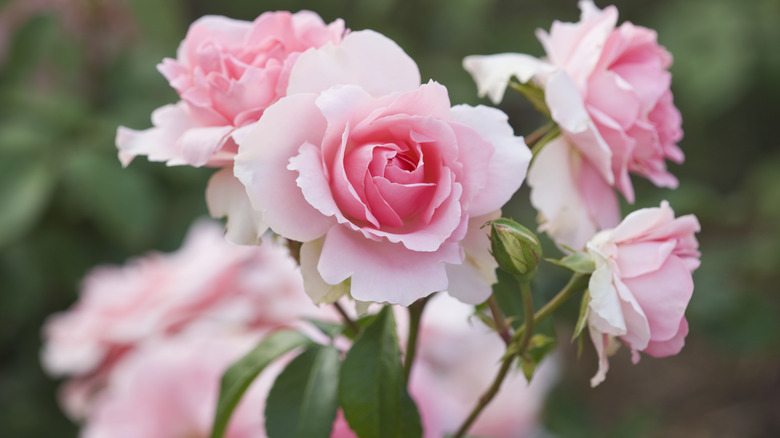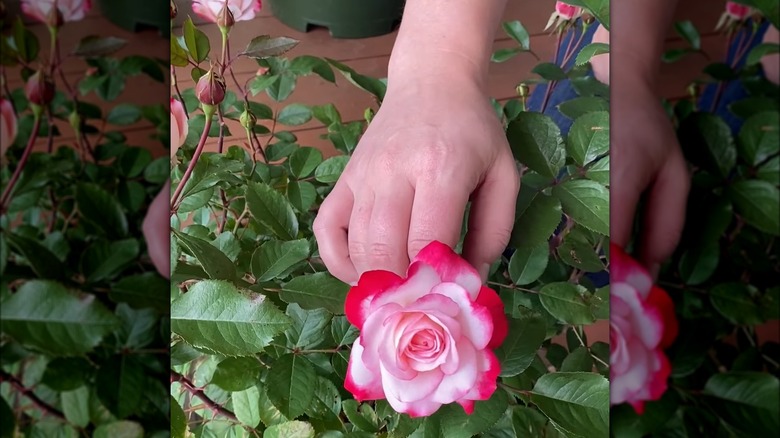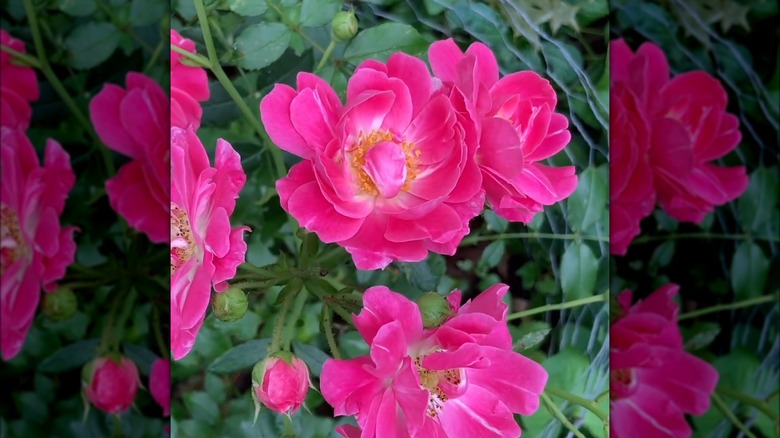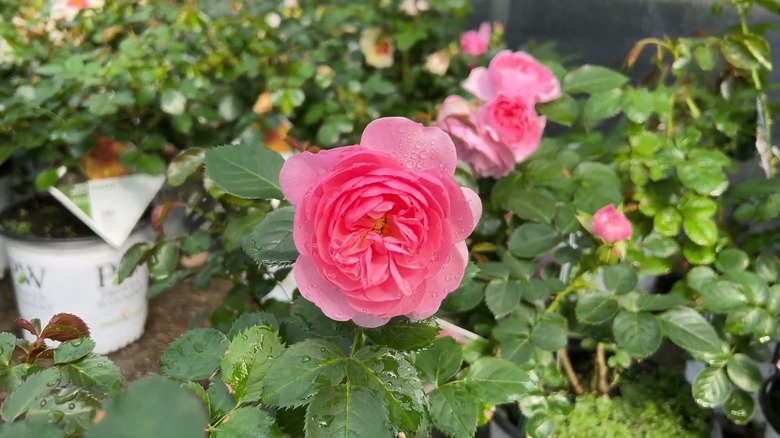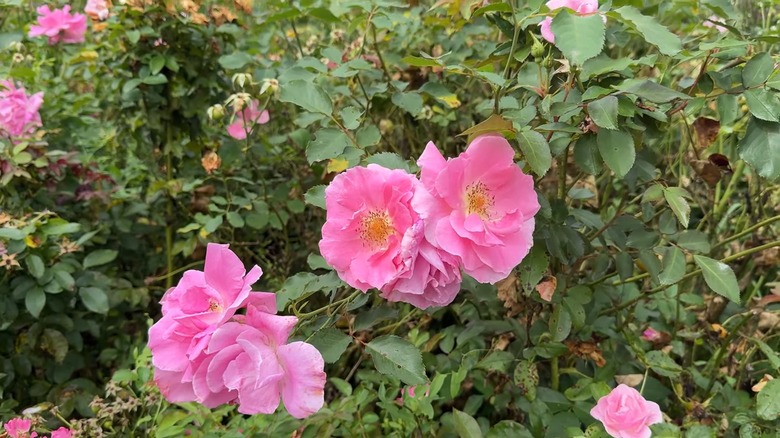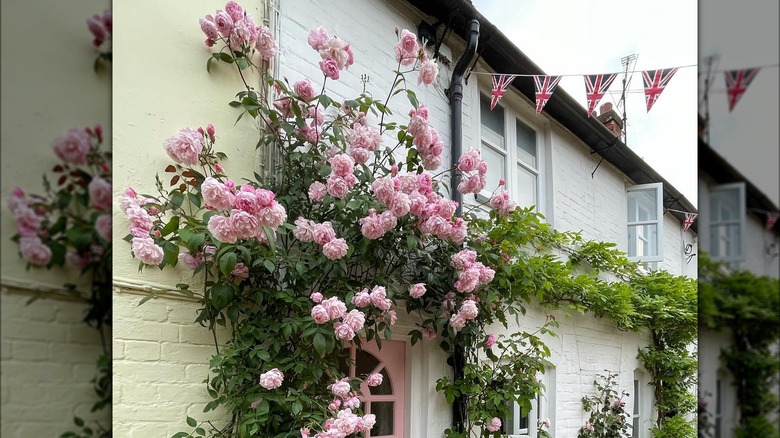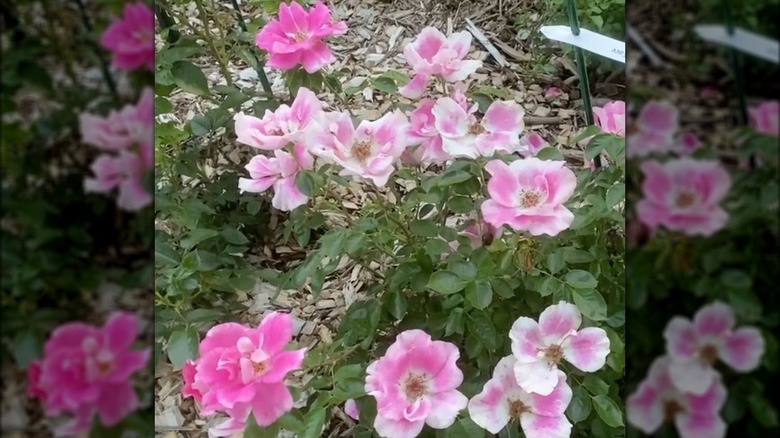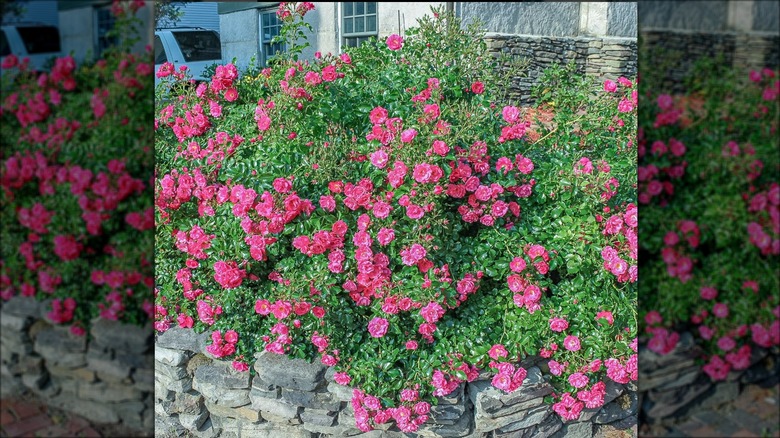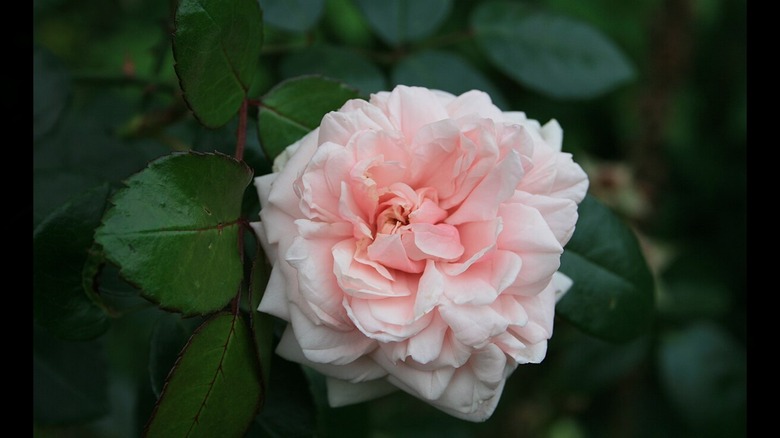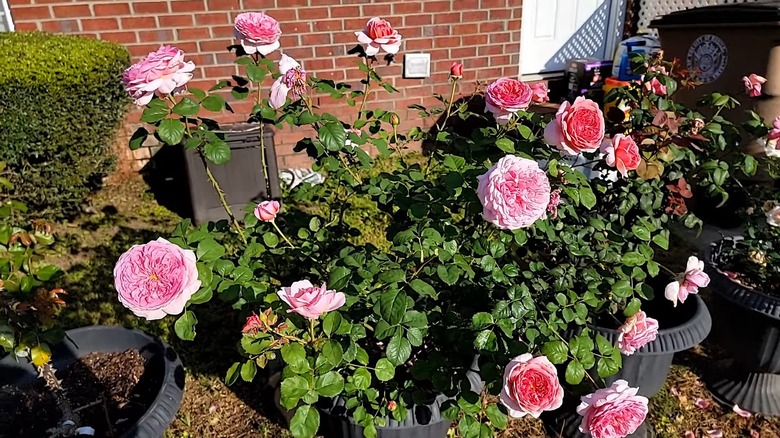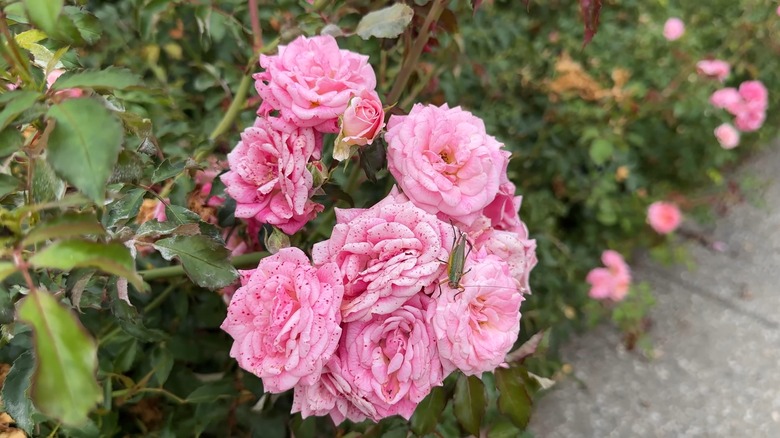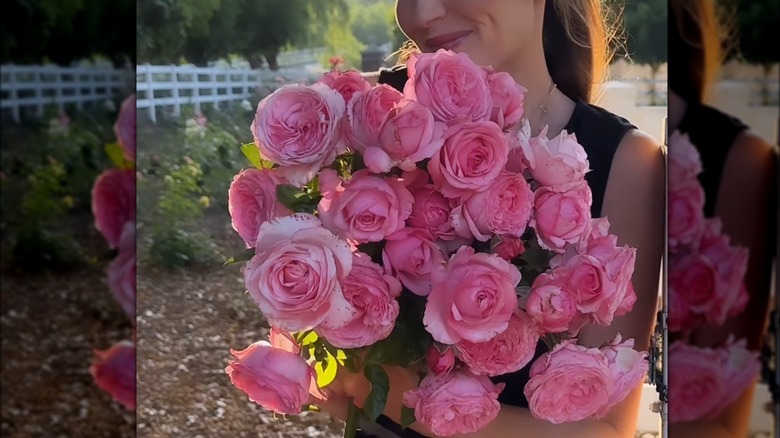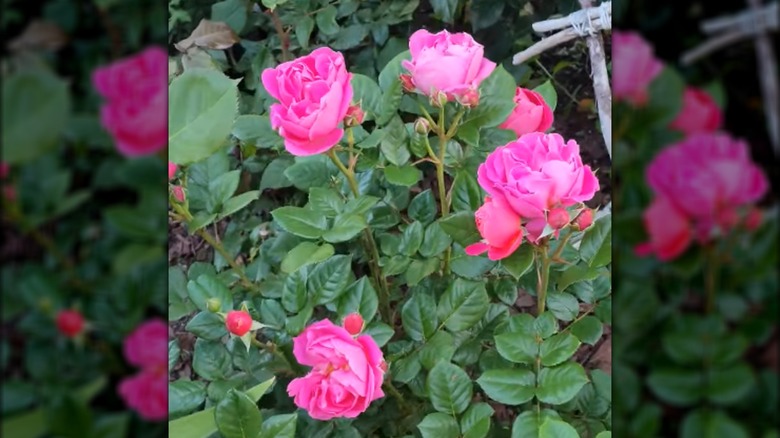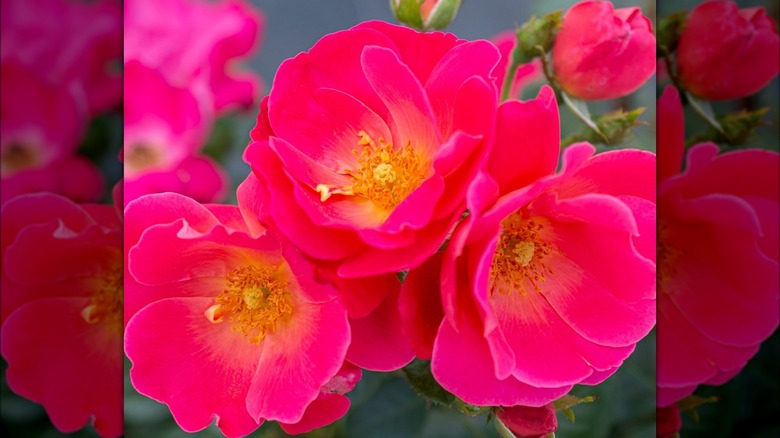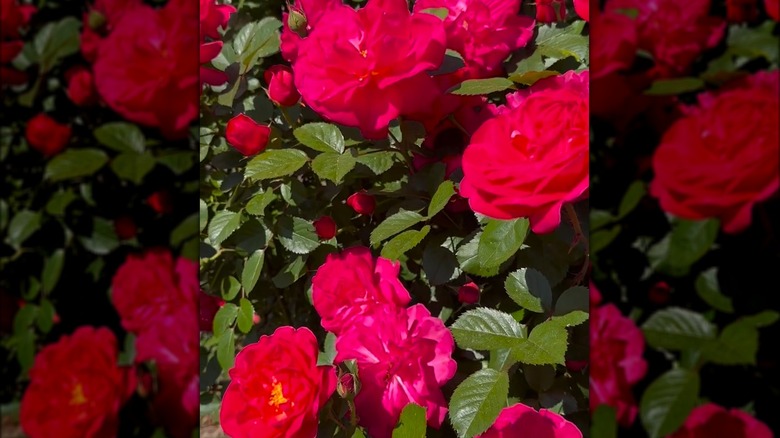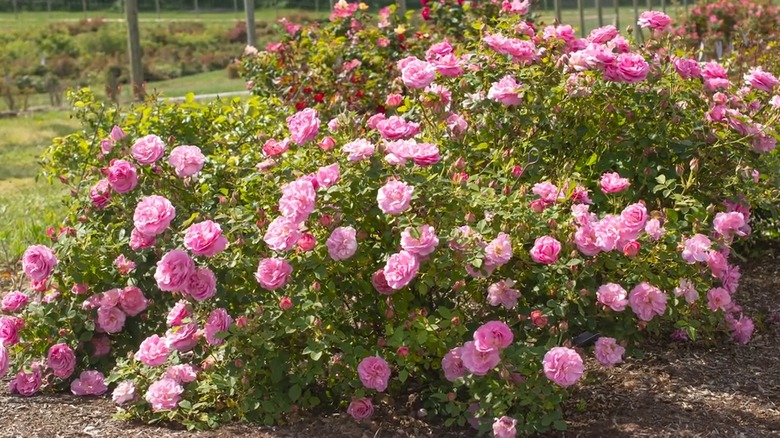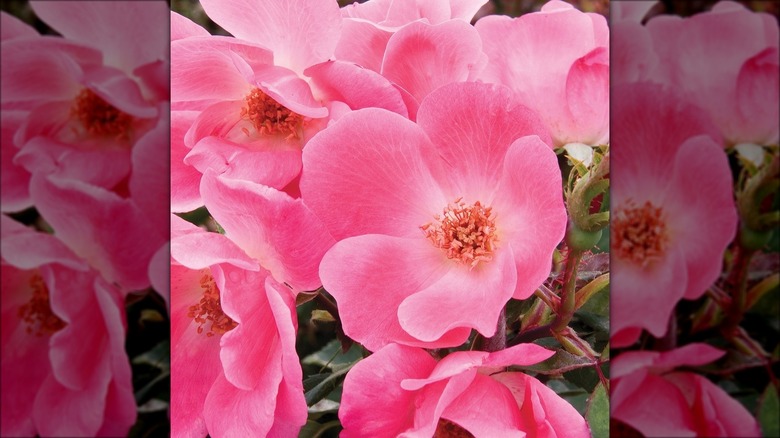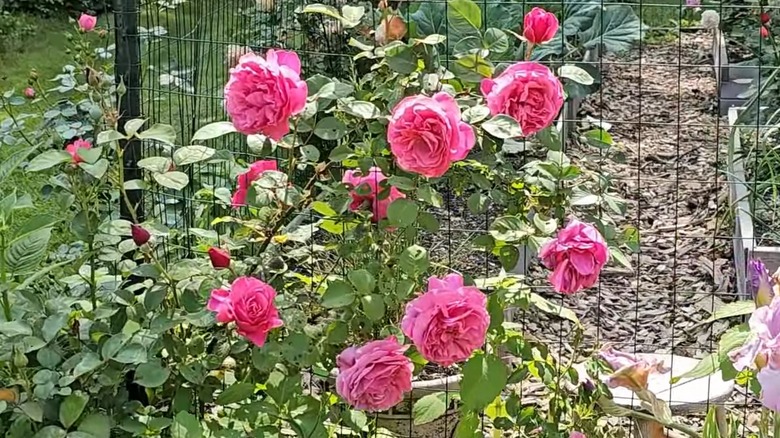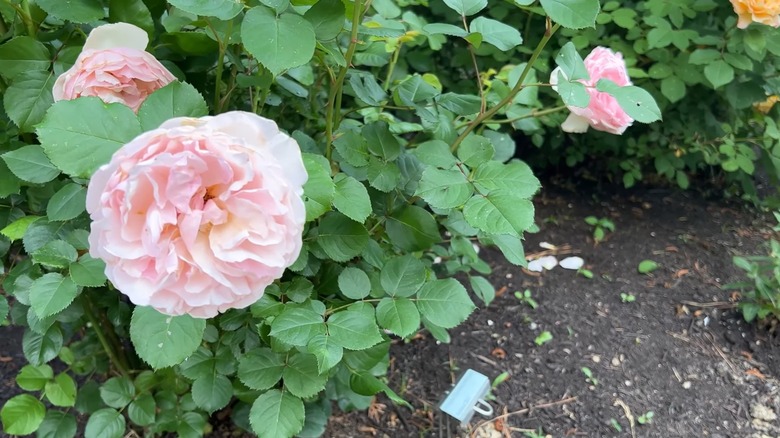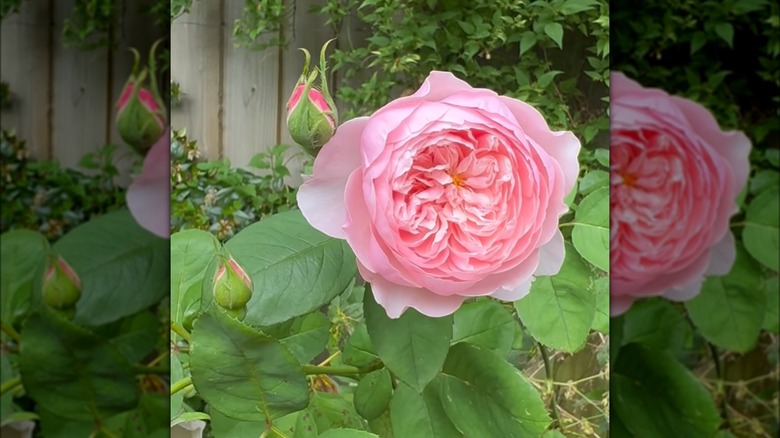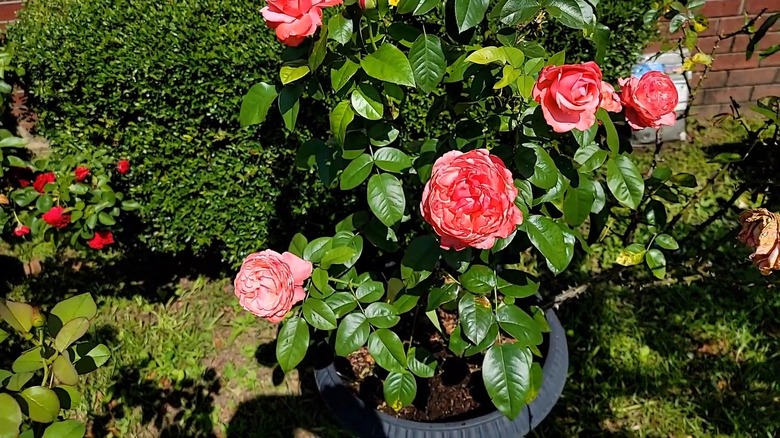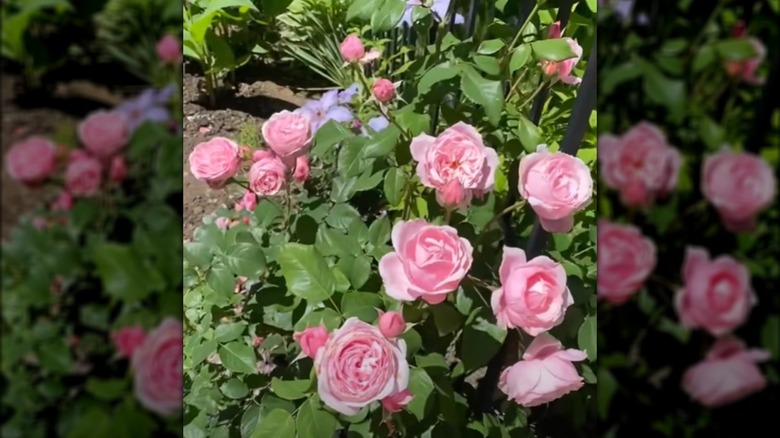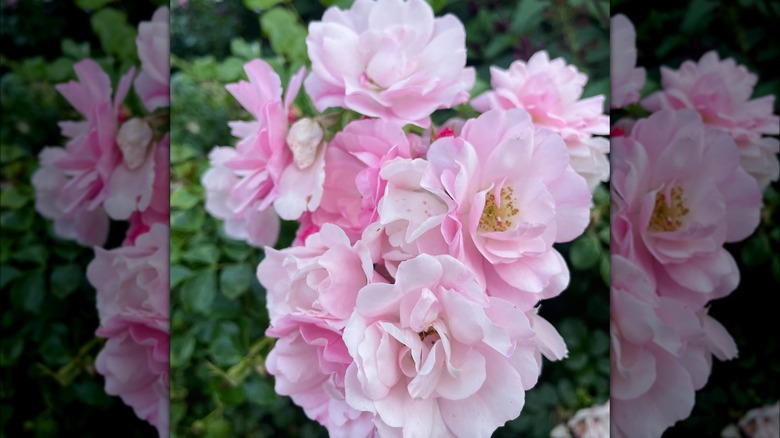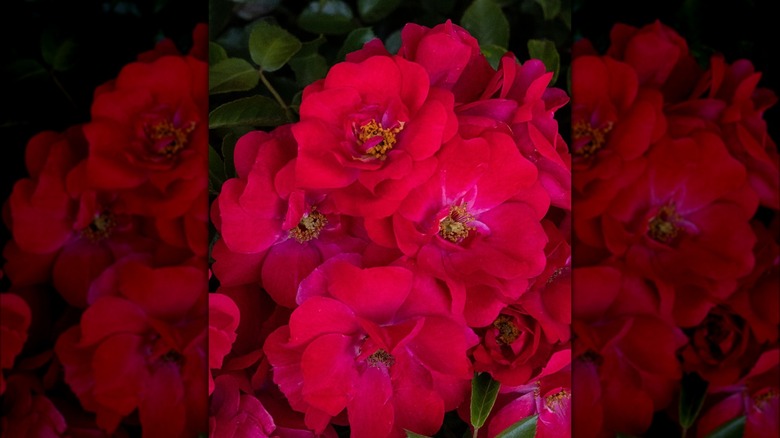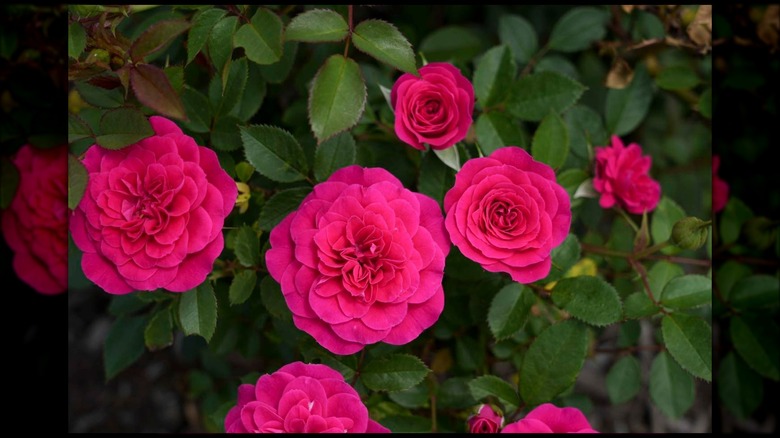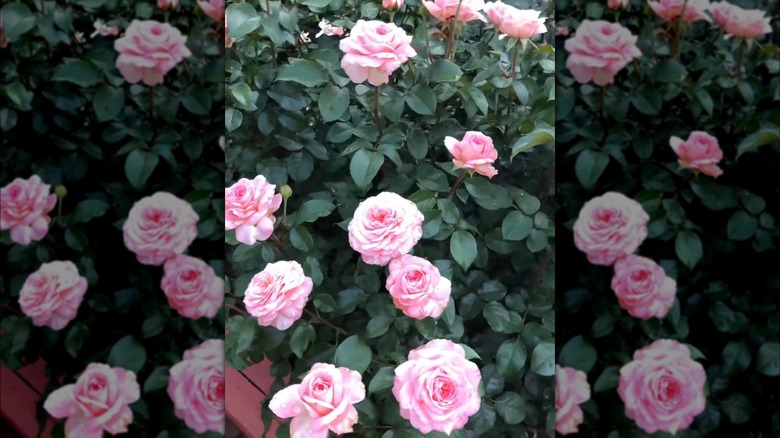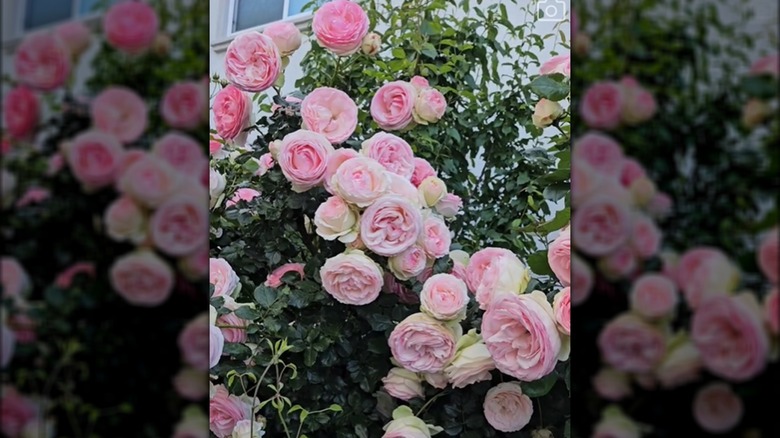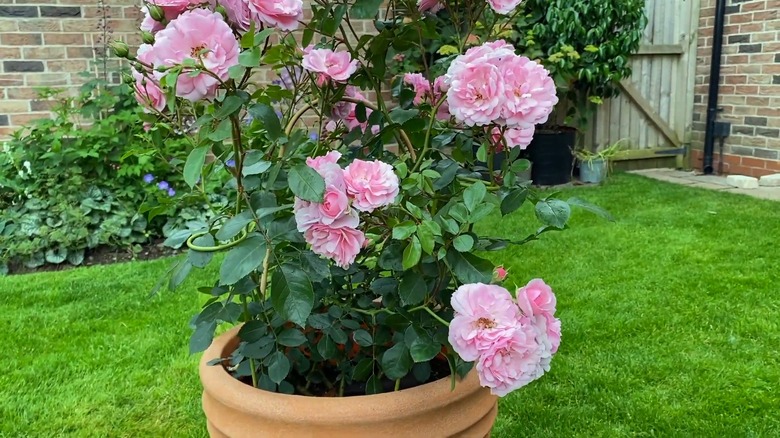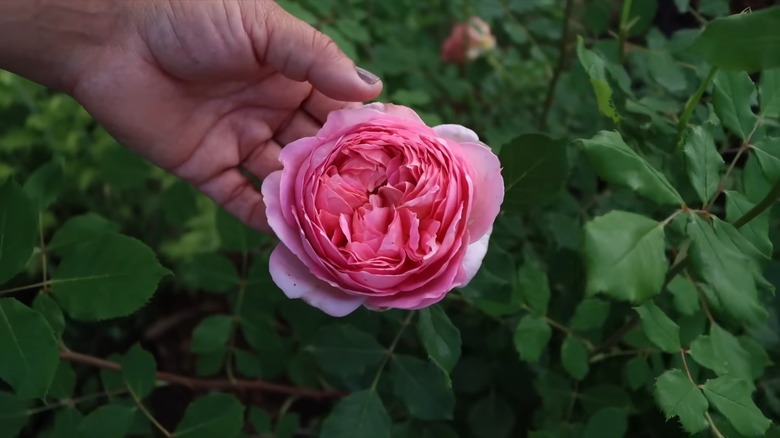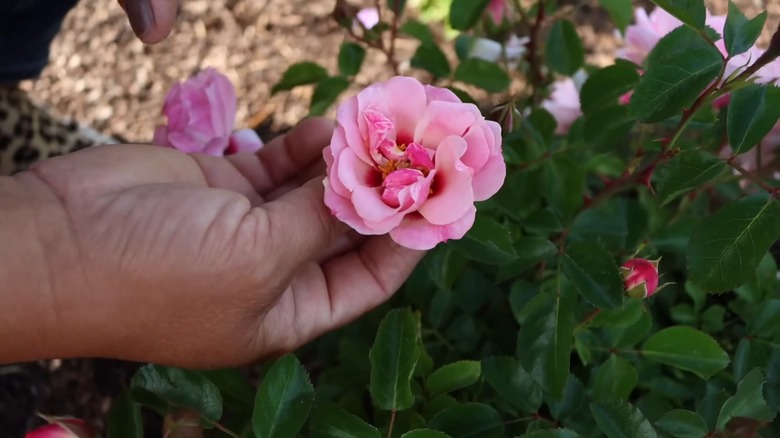29 Pink Rose Varieties To Make A Blushing Garden
Roses aren't always red — thankfully, or our gardens would lack the poetic sweetness brought forth by pink flowers. Emblematic of gentleness, admiration, and deep gratitude, pink roses have been garden darlings since time immemorial and a favorite rendezvous for gardeners looking to step down from the fiery red spectrum. However, as diverse breeders come out year after year with new, heart-stealing varieties, it's only imminent you would feel overwhelmed while selecting the rose variety for your yard. Besides, nobody wants to risk planting invasive multiflora and rugosa varieties.
So, to ease things up, we've compiled a list of pink rose varieties you can grow sustainably in your garden. All you need to do is filter these options based on your site conditions (full or partial sunlight), available space (groundcovers, climbers, or shrubs), and preferences (disease resistance, strong fragrance, vivid shade, and heat or humidity tolerance), and pick the ones that inspire you to write poetry.
1. Grace N' Grit pink bicolor shrub
Monrovia's Grace N' Grit lineup has a resplendent bi-colored variety, Rosa 'Meiryezza,' that can be massed to create living hedges, soften patio edges, brighten south- or west-facing gardens, or plopped in containers. In summer, the shrub roses bloom creamy white flowers that bleed pink along their ruffles and edges, continuing through the fall. Unlike grafted offerings, they grow on their own rootstock (thus, propagated through cuttings) and are highly tolerant of disease, heat, and humidity. They're self-cleaning, meaning these gorgeous rose varieties require no pruning or deadheading, lowering maintenance.
2. Oso Easy Double Pink
A variety winning the American Rose Society's excellence award in 2021 should ideally alert you to the magical fineness of Proven Winner's Oso Easy series, but here's a quick rundown. These roses are remontant to a tee, summer through fall, provided they're given liberal sunlight exposure in USDA zones 5 to 9. With these yellow-eyed, pink petals adorning your perennial beds, you won't have to worry about ways to save your roses from harmful black spot disease or powdery mildew, considering they're already resistant. Staying under 2 feet, they can be grown as groundcovers.
3. Reminiscent Pink
True to their name, Reminiscent Pink roses (Rosa x 'BOZFRA021') smell divinely fragrant, evoking memories of traditional cottage gardens — sans their maladies. In warmer climates, the heat-tolerant roses bloom continuously throughout summer and fall, blushing pink when pollinators descend for a drink. However, they're winter hardy up to zone 4. These deciduous shrubs usually stay under 4 feet tall and 2 feet across and must be cut back early in the spring to improve plant vigor and blooms. First bred in Serbia, the Reminiscent series was introduced in the U.S. by Proven Winners in 2022.
4. Carefree Beauty
Hybridized and introduced in 1977 by Dr. Griffith Buck at the University of Iowa, Carefree Beauty is a semi-double beauty, given to flashing its deep pink tones continuously while the spring warms and eventually cools to frost. As the shrub rose grows 5 feet tall and just as wide, it's best massed in groups of five to add vertical texture to perennial beds or used as a specimen to draw the eye. Orange hips (fruits) may bring fall interest. Cold hardy to zone 4, carefree beauty roses are popular with butterflies.
5. Mary Delany
David Austin's 'Mary Delany' may be among climbing plants perfect for your north-facing wall, but these climbing roses look just as becoming over a trellis or a fence delineating your garden. With support, Mary Delany climbs 15 feet high, enveloping the area in gorgeous, pale pink petals until frost plays spoilsport well after their yellow stamens have made a show. It can be considered thornless (almost) and has found the trick to call in bees by dousing the air with a fruity, old-school rosy aroma. This variety is winter hardy in USDA zones 4 to 11.
6. Easy Elegance Funny Face
The brainchild of Ping Lim and distributed by Bailey Nurseries, Funny Face Rose (Rosa 'BAIface') is for those gardeners who want to paint their gardens in artistic strokes of pink. These 3-foot-tall mounds are topped by everblooming deep pink petals that grow increasingly saturated toward the center and terminate in yellow eyes, ensuring no flower looks the carbon copy of the other. They're highly disease tolerant and adapt to most soils, from slightly acidic to alkaline, but require six hours of sun at minimum to maintain their spring-to-frost appeal.
7. Little Mischief
Mildly aromatic, Little Mischief Rose (Rosa BAIief 'Little Mischief') is perfect for adding fairylike charm to small spaces, especially in mixed borders, as it's quite compact and stays under 3 feet, both top and across. In optimal conditions (full sun and moist soils), it blooms prolifically from May through October, with white-centered, pink petals fading to lighter tones as they mature, bringing about a brilliant monochromatic touch. Hardy through zone 4, Little Mischief roses might play along with Japanese beetles, rose midges, and aphids, but shield themselves successfully from most diseases, including black spot.
8. Awakening
If you've ever researched what it means if the roses in your garden are changing colors, you might've come across scenarios wherein the roses developed sports, and awakening rose (Rosa 'Awakening') is a prime example of it. Though Awakening hasn't upstaged its birth mother 'New Dawn' on account of color, since they're both salmon pink, it has more petals, affording it a full-bodied structure. As you can venture, it translates to more depth for the trellis or arbor upon which this 14-foot-tall climber hangs. Surprisingly, it feels right at home in moderate shade and has bees for friends.
9. Princess Alexandra of Kent
Your search for pink rose varieties that will make your garden smell heavenly is sure to take a long pause (if not a full stop) at 'Princess Alexandra of Kent,' another David Austin-bred, butterfly-friendly variety. Opening over 130 bright pink petals like a Regency-era gown, these large blooms will leave you craving royal tea every time you walk past them, but will mix in lemon and black currant aromas as the weather warms. These princess roses can grow quite large, topping 5 feet, so make sure to give them ample space; even partially shaded areas work.
10. Sweet Drift
If your simmering romance with Knockout roses ended prematurely because the shrubs grew too tall for your garden beds (and tastes), you can swap them out for similarly tasteful, but compact, sweet drift roses (Rosa 'Meiswetdom'), licensed by Star Roses and Plants from the renowned French breeder Meilland. Marketed as groundcover roses for their 1½-foot height and 2½-foot spread, these sun-loving, tiny pink petals will saturate your garden with pleasant aromas and pollinators until the first hard freeze. Their glossy green foliage is unaffected by rust and mildew, but may fall prey to chili thrips.
11. Romantica ball gown
Another rose variety from The House of Meilland, Romantica ball gown (Rosa 'Meipapey') features high up on 2024's list of stunning new plants to add to your garden that you probably haven't heard of. Hardy in growth zones 5 through 11, this hybrid tea variety leaves its onlookers entranced when it pleats their gardens in full-bodied, classic pink roses from spring to summer. While you could leave the 6-foot-tall shrubs in ornamental beds to enjoy the whiff of powdery floral and grassy fragrance they emit, these beauties deserve a place indoors in your floral arrangements.
12. PowerPuff Pink
Developed by Dr. James Sproul, PowerPuff Pink (Rosa 'Spropuff') is a bushy floribunda that decks its green foliage with small clusters of rounded, peony-like buds from spring through fall. These buds eventually unwrap into electric pink roses, eliciting the attention of diverse pollinators, including bees. At maturity, you'll catch the PowerPuff roses standing 4 feet tall and half as wide, radiating a faint linen-ish or lemongrass scent. Give the deciduous bloomers ample sun and well-draining soils in USDA zones 5 to 11 to ensure they don't have to test their disease tolerance levels.
13. Brick House Pink
With a nod from the American Rose Society for its spectacular performance in diverse growth conditions and having received the UC Davis Blue Ribbon for its drought and heat tolerance, Brick House Pink (Rosa 'Sprogreatpink') is a rockstar addition to a blushing garden, deck, patio, or containers. It sports a 2½-foot square green mound festooned with cup-sized, luminous pink petals that bloom in successive flushes, starting with spring and right up to the first frost, magnetizing pollinators. These mildly fragrant, extremely disease-resistant floribunda roses are fully adapted in USDA zone 5 and above, in sunny sites.
14. Highwire Flyer
Crossbred by Will Radler back in 2006, Highwire Flyer (Rosa 'RADwire') is a 6-foot-tall climbing rose that will wreath your trellises, arbors, screens, fences, or utility poles in a sea of hot pink with coral overtones as a bonus. Alternatively, you can mass the vigorous spring-to-fall bloomer at the back of the border — plenty useful when the disease-resistant climber is nearing 30 and balding at its base — or as a hedge to experience the front-seat view of myriad butterflies and bees sipping the sweet nectar. Its exceptional cold hardiness makes it a quick shoo-in in northern gardens.
15. Sitting Pretty
2024 American Garden Rose Selections testing program winner, Sitting Pretty rose (Rosa 'RADbeauty') is for gardeners seeking a compact 4-foot bushy mound that sits pretty (as the name goes) in their floral beds, puts up a good fight against pests and diseases, and has robust cold hardiness (zone 4 and above works). Come spring, the grandiflora rose devolves into a ruffled passel of yellow-stamened, papery pink roses that serve as sturdy landing pads for bees and other pollinators. If potted and positioned on the deck or a patio, you'll surely find their deep linen fragrance highly gratifying.
16. Pink Knock Out
Amidst a sea of roses that depend on good cultural conditions, especially full sun exposure to defend their foliage against black spots, Pink Knock Out (Rosa 'Radcon') is a standout for achieving this and more in partial shade (around three sunlit hours). Atop a 3 by 4 foot mossy mound, it produces a lush flock of slightly aromatic, bubble gum pink flowers, regardless of the heat or humidity. Although it requires no deadheading, doing so will improve the flush frequency (and butterfly calls), as will an annual haircut to keep the rose bush vigorous and pretty.
17. Dee-Lish
To attract butterflies to your garden and begin your mornings by breathing in an intoxicating citrusy scent, plant France's 'Forget-Me-Not,' otherwise known as Dee-Lish (Rosa 'Meiclusif') in the U.S. A hybrid tea variety, Dee-Lish produces large, fuchsia to deep pink roses that contrast beautifully with its maroon-stained, silvery-green foliage. The award-winning rose measures twice its span in height, approximately 6 feet, with its blooms retaining their color regardless of how the sun cranks up the heat. It's highly tolerant to most diseases and can duly brave through zone 5 winters.
18. Princesse Charlene de Monaco
Any experienced gardener knows what really happens to your garden during periods of excessive rain: Pathogens gain a foothold and black spots appear on rose shrubs. But by growing Princesse Charlene de Monaco, a hybrid tea rose variety, you deny the disease any chance of showing up. The regal namesake hails spring with apricot-pink blooms that grow deeper as the season heats up, magnetizing a litany of butterflies with their fruity aroma — or homeowners who cut the flowers for arrangements. It might get up to 6 feet, but requires no staking, making a flowery hedge.
19. The Alnwick Rose
Another David Austin creation, the Alnwick Rose (Rosa 'Ausgrab') deserves a spot in your garden beds, mixed borders, hedges, containers, or along sidewalks solely based on its pretty habit and decent disease tolerance. It grows to a compact 4-by-3-feet size, with its top literally smothered by the mass of 120-petaled pale pink blooms multiple times throughout the summer, going up to frost. Cold hardy in USDA zones 4 through 11, Alnwick roses exude a sweet smell reminiscent of raspberries, provided they're sited in ample sun and well-draining soils.
20. Pink Flamingo
Recognized by the Portland Rose Society for its superior performance in the Pacific Northwest, Pink Flamingo (Rosa 'Meikolyma') is another grandiflora introduction from Meilland. While it's at its best when its salmon pink petals are unfurling — as if flamingos are celebrating the spring's crossover to summer — they're equally enchanting when they aren't actively blooming because of their lustrous, deep green foliage. Small space or container growers will appreciate its tiny 2½ foot waist, tea smells, and defense against common rose malaises, although their thorns can be a sore point. The rose is winter hardy to USDA zone 5.
21. Arborose Kiss Me Kate
Bred by Kordes, Arborose Kiss Me Kate rose (Rosa 'KORnagelio') is a beautiful, blousy pink rose variety that's right at home on a fence, lattice, or any other support structure in USDA zones 5 through 9. However, you can bring the cut roses inside too to grace your dining table. That said, the climber's biggest perk is its fragrance, which will put most perfumes to shame with its blend of raspberry, citrus, and apple. It also does an exceptional job fighting off black spots and mildew. Entice it with full sun so it climbs 10 feet high.
22. Flower Carpet Appleblossom
The Flower Carpet series boasts a high resistance to foliar diseases, salt, heat, drought, and pollution, making them perfect around coastal gardens, as massed covers along the sidewalks, or as border fronts in water-wise gardens. Standing over 2 feet while crowned by pastel pink blooms from spring through frost, Appleblossom roses (Rosa 'Noamel') make splendid groundcovers — just make sure to space them over 3 feet apart. They can also be trained as potted tree roses to deck up patios or a porch. Deadheading isn't necessary, but juveniles will require winter protection in Zone 5.
23. Nitty Gritty pink
Like the Grace N' Grit series, Nitty Gritty® roses aren't grafted, growing atop their true roots and are self-cleaning, which reduces major upkeep. However, they're wider than tall, topping at 3 feet, reducing their use case to a groundcover or multi-colored hedge rows if teamed with other colorful varieties from the series. Pink Rose (Rosa x 'RUIRI0125A') imbues spring and summer in vivid, magenta double blooms, with occasional waves in the autumn. They're water-wise, pet-friendly, and showcase good endurance against salt, pests, and diseases. Plant them in sunny sites containing loamy soils and good drainage.
24. Sunblaze Dragon Fruit
Newly introduced in 2024, Meilland-bred Dragon Fruit (Rosa 'Meiheliot') is the hardiest of its Sunblaze series brethren, as it easily keeps most rose sicknesses at a bush's length. It adds a bold touch to the garden with its short 1½ feet tall frame that's loaded with miniature roses in deep pink to magenta tones, sometimes bordering on reds. A mildly fragrant, prolific bloomer with a compact habit makes it best in mixed borders or containers. Fully adapted in USDA zones 5 through 11, Dragon Fruit roses require at least six hours of direct sun exposure and consistent watering.
25. Sunbelt Savannah
Considered the best of the 2015 hybrid tea rose lot at the Biltmore Rose Trials, Sunbelt Savannah (Rosa x 'KORvioros') is a must-have salmon pink beauty if you prize fragrance over everything else, because it smells exquisitely citrusy. Savannah buds over 150 petals in a single flower head when allowed to soak in sun until its heart's content, regardless of the humidity. After its done blooming late in the summer, it maintains an appeal via it dark green leaves. Sitting cutely at under 4 feet, it is an expert at keeping all galling pests in their place.
26. Eden Climber
When a variety earns the title of "World's Best Rose," by World Federation of Rose Societies like Eden Climber (Rosa 'Meiviolin') did in 2006, you know you're in for a treat. It is a fast grower, rapidly canvassing a trellis, espalier, barrier, or screen in its rich, glossy green, 12-foot length. Around spring, it kicks up the ante with its pastel pink flowers, suffused in shades of creamy halos, outlasting summer. Eden can withstand salt sprays, making it a favorite in coastal gardens. Its repeat blooming, pest resistance, and pet affability further add to its charm. It is cold hardy up to zone 5.
27. Bonica
For a truly reliable variety, grow Bonica (Rosa 'Meidomonac') in zones 4 to 11. While it may not be lavishly fragrant, it's unmatched in its prowess to resist diseases. Moreover, Bonica features amongst the rare few rose varieties that happily sit in partially shaded areas without becoming an eyesore. It lights up gardens with its medium-sized, candy pink petals come spring, and is often seen dotted by a bevy of pollinators late into the fall. You might want to skip removing the spent blooms of this rose, as the ensuing orange hips add spectacular winter interest.
28. Jubilee Celebration
To riddle your garden (and stomach) with butterflies, pivot to David Austin's Jubilee Celebration (Rosa 'Aushunter') variety. This 4-foot-tall English rose shrub supports a domed mountain of coral pink flowers with golden undersides that look beautiful spread-eagled against a sidewalk, patio, or doorway. Younger buds give off a zesty fragrance that eventually matures into a raspberry mélange. In mixed ornamental beds, pair off the celebratory rose with lavender or salvia, but make sure they aren't left hungering for sunlight. Fertile, well-draining soils are a must to coax the roses to keep blooming until frost hits.
29. Ringo Double Pink
Developed by Chris Warner, Ringo Double Pink roses (Rosa x 'ChewDelight') are some of the best heat-tolerant, long-blooming rose varieties, as its recognition at the Hague Role Trials would attest. Unless you're placing these shrubs in shaded, poorly-draining sites, you're unlikely to deal with black spot diseases; instead, spend your time drooling over the deep pink buds unfolding to creamy pink petals with wine eyes, as the summer kicks in. Pruning the plant early in spring before it starts budding will stimulate better blooms. It is hardy in zones 4 through 9.
